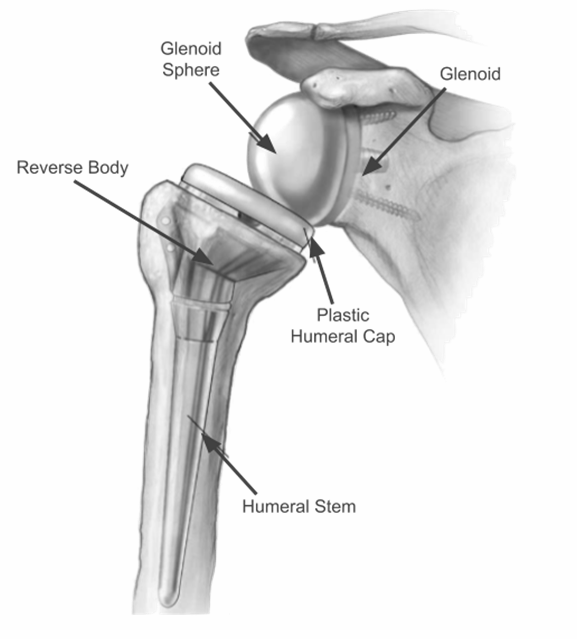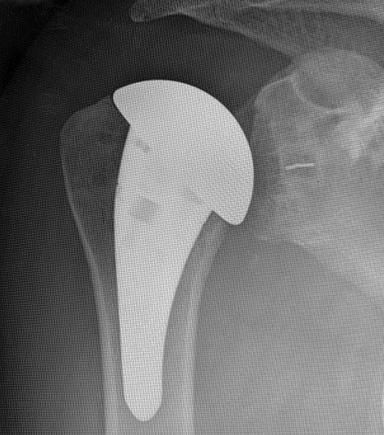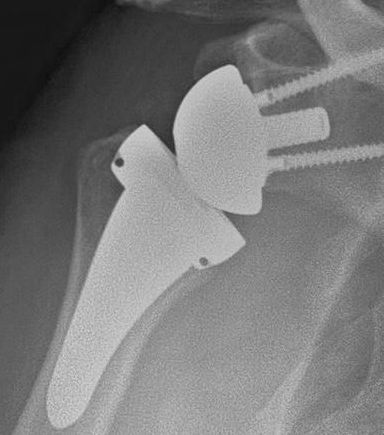Reverse Total Shoulder Replacement
What is Reverse Total Shoulder Replacement?
Reverse Total Shoulder Replacement (RTSR), or Reverse Total Shoulder Arthroplasty (RTSA), is a surgical procedure designed to alleviate chronic shoulder pain and dysfunction by replacing the damaged shoulder joint with an artificial joint.
In contrast to a traditional shoulder replacement, where the ball and socket components of the joint are replaced in their normal positions, RTSR reverses the ball and socket components to provide a stable joint and improved function.

Who is Suitable for Reverse Total Shoulder Replacement?
RTSR is typically recommended for individuals who have:
- Rotator cuff tears that cannot be repaired
- Severe shoulder arthritis with a rotator cuff tear
- A previous shoulder replacement that has failed
- A complex or non-reconstructable shoulder fracture
- Severe shoulder pain and difficulty in performing overhead activities
- Continued pain despite other treatments such as rest, medications, cortisone injections, and physiotherapy
Over time, the reverse replacement has proven to be a durable implant. It has expanded to include more conditions, such as osteoarthritis with advanced bone wear and poor rotator cuff tendon or muscle quality.
Benefits of Reverse Total Shoulder Replacement
- Pain relief: RTSR can alleviate chronic shoulder pain caused by severe arthritis, rotator cuff tear, or other conditions.
- Improved shoulder function: After surgery, patients can often regain shoulder mobility and strength, improving their ability to perform daily activities and improving their quality of life.
- Increased range of motion: RTSR can often restore the ability to raise the arm overhead, which may have been lost due to a rotator cuff tear or other shoulder conditions.
- Improved quality of life: Patients often experience significant improvements following RTSR, including reduced pain and increased independence in daily activities.
Types of Reverse Total Shoulder Replacement
- Grammont-style RTSR: This type involves placing the artificial joint's centre of rotation a lot closer to the shoulder blade than the centre of rotation of the normal shoulder.
- Lateralised RTSR: In this type, the centre of rotation of the artificial shoulder joint is still closer to the shoulder blade than the normal shoulder but is not as close to the shoulder blade as with the Grammont style. This design allows a better range of motion and decreases the risk of the socket bumping into the shoulder blade.
Alternative Options to RTSR
- Conservative treatments: These may include physical therapy, medications, such as nonsteroidal anti-inflammatory drugs (NSAIDs) and corticosteroid injections. Conservative treatments can help manage pain and improve function.
- Arthroscopic surgery: This minimally invasive surgery can repair or remove damaged tissue in the shoulder joint. It may be suitable for patients with mild to moderate shoulder damage.
- Traditional shoulder replacement: In some cases, a conventional shoulder replacement, where the ball and socket components are placed in their normal positions, may be a suitable option for patients. However, this is not recommended for patients with severe rotator cuff damage or other complex shoulder issues.
Differences Between Traditional Shoulder Replacement and RTSR
Traditional shoulder replacement surgery involves replacing the ball of the arm bone (humerus) with a metal ball and the socket (glenoid cavity) of the shoulder blade (scapula) with a plastic socket.
If this surgery is used to treat rotator cuff arthropathy, the shoulder's range of motion will be poor. Therefore, a specifically designed surgery was developed called RTSR to be employed in such cases.
In RTSR, the placement of the artificial components is essentially reversed. In other words, the humeral ball is replaced by a plastic socket on top of the arm bone and the socket (glenoid) on the shoulder blade (scapula) is replaced by a metal ball. This design efficiently uses the deltoid and large shoulder muscles to compensate for the torn rotator cuff.
Preparation for Reverse Total Shoulder Replacement
Before undergoing RTSR, your surgeon will likely ask you to:
- Stop taking certain medications that may increase the risk of bleeding or interfere with anaesthesia.
- Undergo preoperative tests like blood tests, electrocardiogram (ECG), and chest X-ray.
- Stop eating or drinking for about six hours before the surgery.
- Arrange for a caregiver to assist you after the surgery.
Reverse Total Shoulder Replacement Surgery


RTSR takes about two-three hours to complete and is performed under general anaesthesia. Here are the steps in the RTSR procedure:
- Incision: Your surgeon will make an incision in your shoulder to access the joint.
- Joint removal: Your surgeon will remove the damaged or diseased joint. This may include removing the ball and socket components of the joint.
- Preparation: Your surgeon will prepare the bone surfaces for the new artificial joint. The metal ball component of the artificial joint will be attached to the scapula, and the plastic socket component will be attached to the humerus.
- Implantation: The artificial joint will be implanted into the prepared bone surfaces. Your surgeon will ensure the components are properly aligned to provide stability and function.
- Closing incision: After the artificial joint has been implanted, your surgeon will close the incision with stitches or staples.
- Recovery: After the surgery, you will be taken to a recovery room while the anaesthesia wears off. You will be closely monitored during this time.
RTSR Surgery Postoperative Care
Patients can get out of bed on the same day of the surgery but usually stay in the hospital overnight. General postoperative instructions include:
- Pain management: You will experience pain after the surgery. Your doctor will provide you with pain medications to manage your discomfort. It is important to take the medication as prescribed and to report any severe or persistent pain to your doctor.
- Immobilisation: You may be required to wear a sling or other immobiliser to support your shoulder during the initial healing phase. Your surgeon will provide specific instructions on how long to wear the immobiliser.
- Physical therapy: Your surgeon will recommend physical therapy to help restore your shoulder function and strength. You may start physical therapy soon after the surgery or after a short period of immobilisation. Physical therapy may include exercises to improve range of motion and strength.
- Wound care: Keeping the incision site clean and dry is important to prevent infection. Your surgeon will provide you with specific instructions on how to care for the incision site.
- Follow-up appointments: You must schedule regular follow-up appointments with your surgeon and physiotherapist to monitor your progress and ensure proper healing.
- Lifestyle modifications: Your surgeon may recommend certain lifestyle modifications to help prevent complications and promote healing. This may include avoiding certain activities or movements that damage the new joint and maintaining a healthy diet and weight.
Reverse Total Shoulder Replacement Prognosis
The prognosis for RTSR is generally positive, with many individuals experiencing significant pain relief and improved shoulder function. However, the procedure's success depends on several factors, including the individual's overall health and the severity of their condition.
A pre-operative review by any treating specialist (e.g. cardiologists) is recommended. Patients may outlive the lifespan of the artificial joint. Approximately 80% of implants were retained 15 years after insertion. The longevity should improve with better plastics and design.
Reverse Total Shoulder Replacement Risks
Possible risks and complications associated with RTSR surgery include:
- Infection
- Stiffness
- Nerve and vascular injury
- Dislocation or instability of the implanted joint
- Fracture of the humerus or scapula
- Damage to nerves or blood vessels
- Blood clots (deep vein thrombosis)
- Wound irritation
- Arm length discrepancies
- Wearing out of the components
- In an elderly population, stroke and heart attack risks are higher.
What if Reverse Total Shoulder Replacement is Delayed?
If RTSR is delayed, there are still alternative treatments available that may help manage shoulder pain and improve function. Depending on your specific condition, your orthopaedic surgeon may recommend conservative treatments, such as physical therapy, medications, and injections.